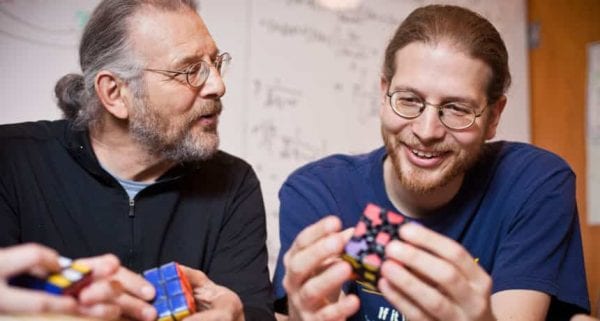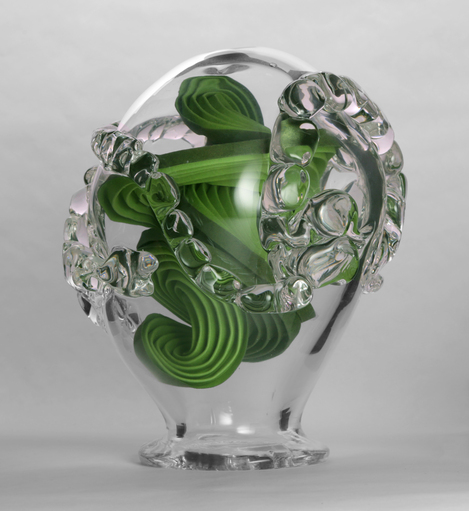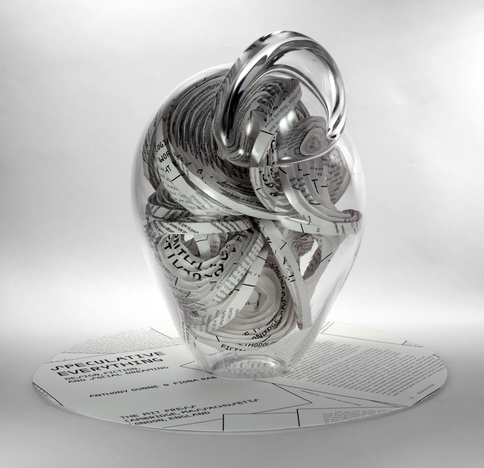
See What Unfolds |
The Curved-Crease Sculpture of Erik & Martin Demaine
The artists/mathematicians merge art and science with stuntwork, performing a blindfolded glass-blowing demonstration at Duncan McClellan Glass.
August 9, 2019 | By Julie Garisto
Folding paper along curved creases transforms into swirling sculpture that feels alive, say sculptors Erik & Martin Demaine. The father-son team have made it their mission to find new ways to create art using this process and educate the rest of us on the possibilities of shapes with self-folding origami. Their striking works of glass and paper can be seen in the Museum of Fine Arts large-scale origami exhibition Above the Fold, and – opening Saturday – the exhibit A Fold in Time at Duncan McClellan Glass.
Having worked with both institutions in the past, the dad and son are returning to St. Petersburg to present a lecture and blindfolded glass-blowing demo during the opening day festivities at Duncan McClellan Glass, in conjunction with the Second Saturday Art Walk, 5-9 p.m. on Saturday, August 10.
Why blindfolded? The Demaines have worked together for several years in both glass sculpture and paper sculpture, and say that they wanted to explore how they communicate with the material.
Because paper relies on touch, the tactile interaction lets the artist, “talk to the paper, asking it to bend, and you can hear the material responding, as the folds form the shape.”
Because molten glass is more than 2000 degrees Fahrenheit, it’s untouchable. Glass blowers, of course, rely on visual cues to communicate and shape the material. “In order to make it relate to paper folding, we blow glass blindfold, leaving touch as the only way to communicate,” Martin Demaine explains here. “Touch is possible through a thin layer of wet paper, which serves as the communication interface between the artist and the material. This experiment brought a new sensitivity and awareness in communication with the glass and between paper and glass. After the experience, we returned to making glass while sighted – and found that our perception changed and the physical sensation was heightened, while we continued to shape the hot glass through wet paper.”
Along with Saturday’s demo and talk, the artists/mathematicians will demonstrate their process during the MFA Marly Music Series at 2 p.m. at the Museum of Fine Arts, accompanied by acclaimed jazz pianist/neuroscientist John C. O’Leary III, whose compositions are inspired by a desire to combine music and science, and to bring his community closer to the scientific world.
Together, the three scientists/artists will create a performance piece based on the intersecting notions of left and right brain. The performance is sold out.
Just what is curved-crease sculpture?
The earliest known reference is from a student’s work at the Bauhaus, from a preliminary course in paper study taught by Josef Albers in 1927–28. (Read more about the history of the practice here.) The artists compress folded paper, then relax it into its natural curved form. To control this process, artists must have an understanding of different pleatings and how to design pleatings that make desired forms.
The Demaines not only explore the medium’s naturally occurring equilibrium forms for artistic purposes – they also work with applications to deployable structures, manufacturing, and self-assembly. Their self-folding skills have contributed to life-saving airbags.
In addition, each piece of hand-folded paper with curved creases is housed in a hand-blown glass hollow “head.” These glass heads were made after an experience (documented in the video above) of blowing glass and touching the glass through wet paper — the process that dad Martin “Marty” Demaine will demonstrate Saturday.

According to their website, they use computers to design the sculptures, based on algorithms from the field of computational origami, folding paper along concentric circular creases, the design originating at the Bauhaus in the late 1920s. Creases set the memory of the paper so that it tries to return to a specific dihedral angle, while non-creased paper tries to remain flat. Confined to opening within a glass enclosure, the paper finds new equilibrium forms – forms that would not exist without communication between the materials.
Trailblazing with glass and paper
The senior Demaine is a mathematician and teaches glassblowing at the MIT Glass Lab in Cambridge, Massachusetts.
After studying glassblowing in England and blowing art glass in New Brunswick in the early 1970s, he opened the Demaine Studio in Miramichi Bay and later at Opus Village in Mactaquac, which turned out to be the first one-man glass studio in Canada. He home-schooled Erik, who earned his bachelor’s at age 14 and a Ph.D. and MIT professorship at age 20, making him the youngest professor ever hired by MIT. The recreational mathematics enthusiast and his dad founded the Erik and Dad Puzzle Company which distributed puzzles throughout Canada.
“We use sculpture as a way to express our research to a broad audience, illustrating the beauty of mathematical structures through the design of physical manifestations,” their website says. “We find that the dialog between our scientific work and our artistic work inspires both our art and science in directions that would not be possible in isolation.”

Imagine that: mathematical formulas put to use in real life to create entertaining, stunning sculptural works.
Don’t you wish your high school math teacher was this cool?
The artist talk with Martin & Erik Demaine begins at 5:30 p.m. on Saturday, August 10 at the Duncan McClellan Glass gallery at 2342 Emerson Ave. S., St. Petersburg.
Glass blowing begins around 6:15, followed by live jazz by the Henry Ashwood Jazz Project from 8 to 9:30 p.m.
All proceeds from the bar sales will be donated to Nokumbaya, a non-profit organization that has run missions to some of the most remote areas of the world. They provide child wellness screening and primary care services to villages in Haiti and Belize.
Sadly, the Sunday concert/demo at the MFA is sold out, but last-minute no-shows are always a possibility if you want to try your luck at the museum on Sunday afternoon. Tickets to Marly Music Series performances are $25 for adults and $15 for students and Marly Music Society Members.




